So you have just moved into a new home. It has all of the latest appliances and even a separate water faucet for your drinking water, but how good is the water coming from the water filter, is your drinking water reverse osmosis?
Water that has gone through a reverse osmosis system will taste considerably less salty than your tap water. Unlike a simple filter, reverse osmosis will remove dissolved solids from your water that can give water a salty, bitter, or milky taste and impurities that can cause odors.
Having a water filtering system in your home is a great idea, but if your filtering system is not a reverse osmosis system, you may not be drinking water that is as filtered as you might think.
How Can I Tell If My Filtered Water Is Reverse Osmosis?
- Your filtered water will taste very clean
- Your filtered water will NOT taste as salty as your tap water
- Your filtered water will NOT leave a white residue after it evaporates
- Your water filter system has a storage tank next to it
- Your water filter system has one or more horizontal cylinders on top of it
- Your water filter system has a drain tube connected to your sinks drain
If you have a reverse osmosis drinking water system, it is most likely because of a high amount of dissolved solids in your home’s water that makes for poor tasting water.
A reverse osmosis system will remove up to 98% of dissolved solids in your water leaving the water with a very pure taste.
So if your tap water has a salty taste, the simplest way to know if your drinking water filter is a reverse osmosis system is a salty taste.
Water from a properly working reverse osmosis drinking water system will taste considerably less salty than the tap water from your sink faucet. That is what a reverse osmosis system is for!
See my article “What Does Reverse Osmosis Water Taste Like?“
Reverse Osmosis Water Should Taste Very Clean Compared To Your Tap Water.
The process of reverse osmosis greatly reduces the number of dissolved solids in water that makes for poor tasting water and odors in water.
When a reverse osmosis drinking water system is used, the water that the system produces will have a very clean and crisp taste and mild odors in your home’s water should be removed or greatly reduced.
If you have a water filtering system that is not a reverse osmosis system, your water may taste and smell better than your tap water because some impurities like chlorine and sulfur have been removed from your water but the amount of dissolved solids (like sodium) in your water has not been reduced.
Does Your Drinking Water Taste As Salty As Your Tap Water?
If you can’t taste a difference in the saltiness of the water between the water coming from your drinking water filter and the water coming from your tap, you either do not have a reverse osmosis system or your reverse osmosis system is no longer working.
See my article What does reverse osmosis water taste like?
But if you do notice some improvement in the saltiness of your water coming from your drinking water filter, it may be a reverse osmosis system that just needs to have its filters and membrane replaced.
When the filters and membrane in a reverse osmosis system are new, they should be reducing the amount of Total Dissolved Solids (TDS) in your water by up to 98%.
You can easily test the TDS of your tap water and compare it to the water coming from your drinking water filter with a TDS meter which will test for an approximate amount of Total Dissolved Solids in your water.
But as the filters get clogged and the membrane wears out, the number of TDS that they are able to remove decreases.
This means that even though you may have a reverse osmosis system filtering your drinking water, it may not be filtering your water as well as it could if it had fresh filters and a properly working reverse osmosis membrane.
Does Your Tap Water Leave White Spots But Your Drinking Water Does Not?
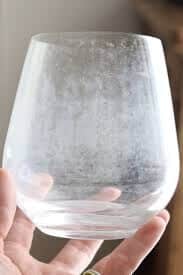
If you have a high amount of sodium in your homes’ water, it can leave sodium residue on surfaces after the water has evaporated.
A drinking water filtering system that is not reverse osmosis will not remove sodium from your water so it will leave the same type of white residue as the water that is coming from your sink faucet.
But, if you put a drop of your tap water on a surface next to a drop of your drinking water and the drinking water drop leaves no white residue as your faucet tap water drop does, you likely have a reverse osmosis system that has removed excess sodium from your water.
Does Your Tap Water Have An Odor But Your Drinking Water Does Not?

Improved taste and reduced odor in your water, does NOT mean that your water is reverse osmosis water.
Most simple water filters use carbon to reduce impurities in your water that can cause poor taste and odors in your water but a reverse osmosis system will also include a carbon filter to produce the same results.
Is There A Storage Tank By Your Drinking Water Filter?
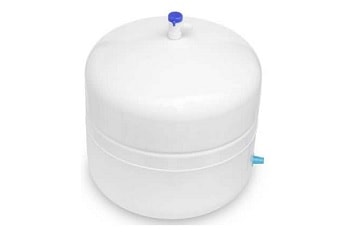
A simple drinking water filter can produce filtered water at a relatively quick rate so when you turn on the faucet of a simple drinking water filtering system the water is flowing through the system and then directly to the water faucet.
However!
A reverse osmosis drinking water system makes filtered drinking water at a very slow rate because the water is forced through a very fine semi-permeable membrane.
Because a reverse osmosis drinking water system makes water so slowly, it uses a pressurized water storage tank to collect the filtered reverse osmosis water and then dispense the water from the storage tank when the drinking water faucet is turned on.
Although some reverse osmosis drinking water systems are able to create reverse osmosis water at a fast enough rate to dispense the water directly from the reverse osmosis system, most reverse osmosis drinking water systems will use a separate water storage tank to store water for when it is needed.
If your drinking water filter does not have a water storage tank connected to it, it is probably not a reverse osmosis drinking water system.
Is There A Horizontal Filter On Top Of Your Water Filter?
The primary difference between a simple water filter and a reverse osmosis system is the semi-permeable membrane that filters the dissolved solids from the water.
This membrane is often located on top of the reverse osmosis system in a horizontal position with a tube connected to each end of the membrane housing.
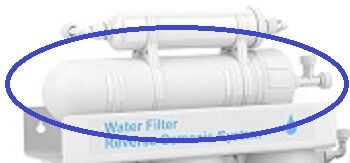
Some reverse osmosis drinking water systems have membrane housings that look very much the same as the housings that hold the filters for the system but will usually have a tube coming out of the bottom of the housing where the filter housings will not have any tubes.
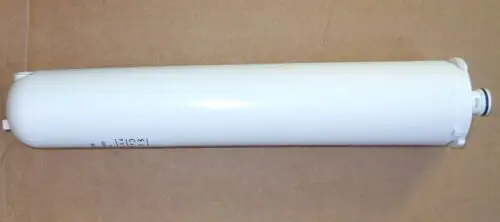
There are a few reverse osmosis drinking water systems that have reverse osmosis membrane housings that look just like the filter housings and do not have tubes coming from them but they are usually labeled “Membrane” and look very different to prevent confusion.

Is There A Drain Line Connected To Your Sinks Drain?
A reverse osmosis drinking water system requires a drain to get rid of the dissolved solids that it has removed from your water where a simple water filter does not.
The drain tube from a reverse osmosis drinking water system will often be attached to the drainpipe of the sink where the reverse osmosis system is located using a drain saddle.

Using a drain saddle, the drain tube will be able to drain the unwanted wastewater from the reverse osmosis system when the system is making reverse osmosis filtered water.
See my article How does reverse osmosis work, and will it benefit you?
What Does A Reverse Osmosis System Look Like?
Reverse osmosis drinking water systems come in many different sizes and styles but they all work about the same as the one in this short video.
But, the most popular style of residential reverse osmosis systems will have three or more vertical cylinders at the bottom, and one or more horizontal cylinders at the top. They will also come with a storage tank and a drinking water faucet.
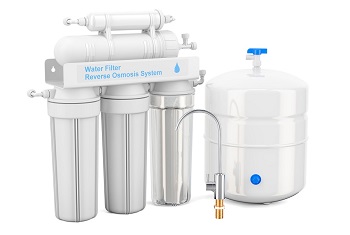
Some have the filters and membrane housings easily visible but others may have their filters and membrane contained within the system.
For the most part, a reverse osmosis drinking water system will have two or more vertical housings hanging from the system and one or more horizontal housings lying horizontally on the top of the system.
Many reverse osmosis drinking water systems will have a removable cover on the top of the system to protect the membrane housing and tubing on top of the system.
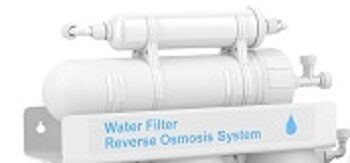
Look For A Label On Your Water Filter That Says “Reverse Osmosis”.
Because manufacturers want to advertise that their system is a reverse osmosis drinking water system, they will often put a label directly on the system itself to make customers aware that the system is actually a reverse osmosis system.
The label may not be easy to find but start by looking at the top cover of the system if it has one, then check for a label that would contain the model number and brand of the system.
Reverse osmosis systems come in various colors but are most commonly white, off-white, black, or grey.
What Does A NON- Reverse Osmosis Filter Look Like?
A water filtering system that is not reverse osmosis will often not have any horizontal housings on the top of the system and will have one or more vertical filter housings.

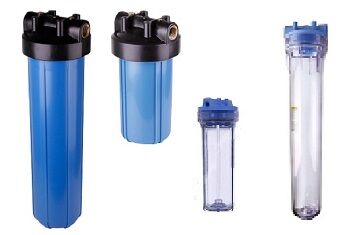
A water filter that is NOT reverse osmosis has no need for a storage tank or a drain tube going to the drainpipe of the sink.
A water filter that is NOT reverse osmosis will most likely only have a water supply tube going into one end of the filter and then a second tube going out of the filter and directly to the drinking water faucet.
Can I Test My Water To Know If It Is Reverse Osmosis?

The only way that you can definitively be sure that your drinking water system is a properly working reverse osmosis system is to test for the Total Dissolved Solids (TDS) coming from your tap water and compare it to the water coming from your drinking water system.
By using a simple to use TDS meter you can get a reading of the Total Dissolved Solids in your tap water.
Then test the TDS of the water coming from your drinking water system.
The reading from your drinking water system should be significantly lower than the reading from your tap water.
If the TDS reading from your drinking water system is 10% or less of the reading from your tap water, the water has had the Total Dissolved Solid amount in your water reduced which means that your drinking water filter is a reverse osmosis drinking water system.
Conclusion:
Not all water filters are created equal!
Just because you see a water filtering system underneath your kitchen sink does not mean that you are drinking high-quality reverse osmosis filtered water.
A basic water filter will work great to remove or reduce sediment, chemicals, and even non-dissolved iron from your water that can improve the taste of your water and remove some odors.
But if you are looking to substantially reduce the amount of sodium and other dissolved solids from your water in addition to removing or reducing chemicals and sediment from your drinking water, a multi-stage reverse osmosis drinking water system can give you far better water than a simple water filter system.

